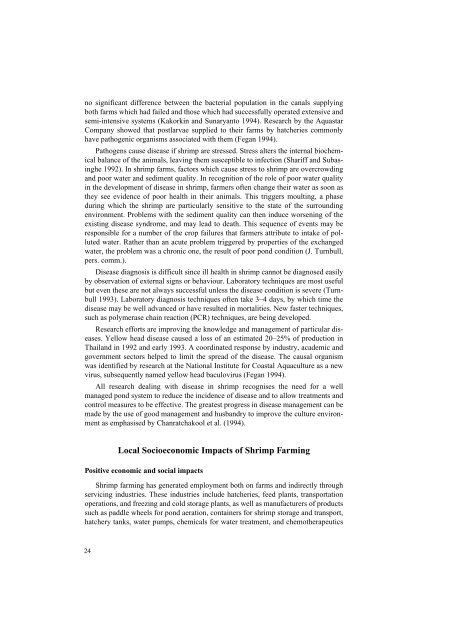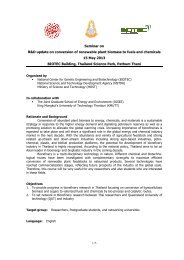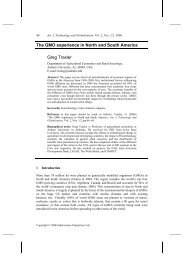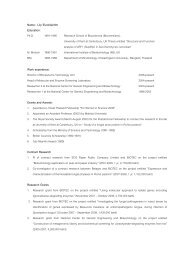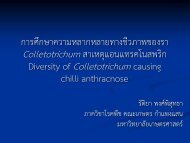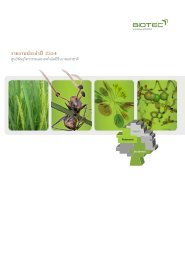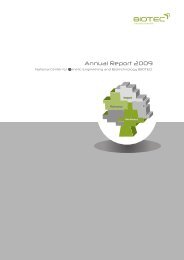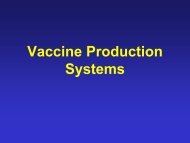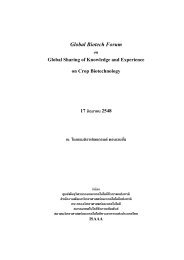!no significant difference between the bacterial population <strong>in</strong> the canals supply<strong>in</strong>gboth farms which had failed and those which had successfully operated extensive andsemi-<strong>in</strong>tensive systems (Kakork<strong>in</strong> and Sunaryanto 1994). <strong>Research</strong> by the AquastarCompany showed that postlarvae supplied to their farms by hatcheries commonlyhave pathogenic organisms associated with them (Fegan 1994).Pathogens cause disease if shrimp are stressed. Stress alters the <strong>in</strong>ternal biochemicalbalance of the animals, leav<strong>in</strong>g them susceptible to <strong>in</strong>fection (Shariff and Subas<strong>in</strong>ghe1992). In shrimp farms, factors which cause stress to shrimp are overcrowd<strong>in</strong>gand poor water and sediment quality. In recognition of the role of poor water quality<strong>in</strong> the development of disease <strong>in</strong> shrimp, farmers often change their water as soon asthey see evidence of poor health <strong>in</strong> their animals. This triggers moult<strong>in</strong>g, a phasedur<strong>in</strong>g which the shrimp are particularly sensitive to the state of the surround<strong>in</strong>genvironment. Problems with the sediment quality can then <strong>in</strong>duce worsen<strong>in</strong>g of theexist<strong>in</strong>g disease syndrome, and may lead to death. This sequence of events may beresponsible <strong>for</strong> a number of the crop failures that farmers attribute to <strong>in</strong>take of pollutedwater. Rather than an acute problem triggered by properties of the exchangedwater, the problem was a chronic one, the result of poor pond condition (J. Turnbull,pers. comm.).Disease diagnosis is difficult s<strong>in</strong>ce ill health <strong>in</strong> shrimp cannot be diagnosed easilyby observation of external signs or behaviour. Laboratory techniques are most usefulbut even these are not always successful unless the disease condition is severe (Turnbull1993). Laboratory diagnosis techniques often take 3–4 days, by which time thedisease may be well advanced or have resulted <strong>in</strong> mortalities. New faster techniques,such as polymerase cha<strong>in</strong> reaction (PCR) techniques, are be<strong>in</strong>g developed.<strong>Research</strong> ef<strong>for</strong>ts are improv<strong>in</strong>g the knowledge and management of particular diseases.Yellow head disease caused a loss of an estimated 20–25% of production <strong>in</strong><strong>Thailand</strong> <strong>in</strong> 1992 and early 1993. A coord<strong>in</strong>ated response by <strong>in</strong>dustry, academic andgovernment sectors helped to limit the spread of the disease. The causal organismwas identified by research at the National Institute <strong>for</strong> <strong>Coastal</strong> <strong>Aquaculture</strong> as a newvirus, subsequently named yellow head baculovirus (Fegan 1994).All research deal<strong>in</strong>g with disease <strong>in</strong> shrimp recognises the need <strong>for</strong> a wellmanaged pond system to reduce the <strong>in</strong>cidence of disease and to allow treatments andcontrol measures to be effective. The greatest progress <strong>in</strong> disease management can bemade by the use of good management and husbandry to improve the culture environmentas emphasised by Chanratchakool et al. (1994).Local Socioeconomic Impacts of <strong>Shrimp</strong> Farm<strong>in</strong>gPositive economic and social impacts<strong>Shrimp</strong> farm<strong>in</strong>g has generated employment both on farms and <strong>in</strong>directly throughservic<strong>in</strong>g <strong>in</strong>dustries. These <strong>in</strong>dustries <strong>in</strong>clude hatcheries, feed plants, transportationoperations, and freez<strong>in</strong>g and cold storage plants, as well as manufacturers of productssuch as paddle wheels <strong>for</strong> pond aeration, conta<strong>in</strong>ers <strong>for</strong> shrimp storage and transport,hatchery tanks, water pumps, chemicals <strong>for</strong> water treatment, and chemotherapeutics+#
!<strong>for</strong> disease control. In 1994, the shrimp culture <strong>in</strong>dustry employed around 97,000people directly and 53,000 <strong>in</strong>directly (DOF 1994).It has been suggested that employment created by shrimp farm<strong>in</strong>g has, to anextent, stopped the movement of local people to Bangkok and other large cities andhas led to an overall economic improvement <strong>in</strong> the purchas<strong>in</strong>g power and sav<strong>in</strong>gs ofrural people (NACA 1994a). The expansion and upgrad<strong>in</strong>g of roads, electricity supplies,municipal water supplies, telephones and other communications, and transportationhave also been attributed to shrimp production (NACA 1994a; Funge-Smith1997). Data from the districts of Ranot and Hua Sai (Piamsomboon 1993) appear tosupport this. Of the shrimp farmers surveyed there, 86% perceived that trad<strong>in</strong>g <strong>in</strong> villages<strong>in</strong> the area had expanded as a result of shrimp farm<strong>in</strong>g and that changes <strong>in</strong> the<strong>in</strong>frastructure support<strong>in</strong>g the villages and farms had occurred. It was concluded fromthese data that there appeared to have been an overall generation of wealth andimproved social and economic conditions <strong>in</strong> the districts as a result of the expansionof shrimp farm<strong>in</strong>g. However, Piamsomboon (1993) <strong>in</strong>dicated that 40% of all farmers(not just shrimp) did not perceive the socioeconomic changes <strong>in</strong> the area to be positive.Further research <strong>in</strong>to this sector of the shrimp farm<strong>in</strong>g community may providea better <strong>in</strong>sight <strong>in</strong>to these changes.Negative economic and social impactsAlthough the shrimp culture <strong>in</strong>dustry has a record of impressive production andexport revenue figures, and many have profited from the <strong>in</strong>dustry, there are alsothose who have been displaced by and suffered because of its expansion. Thesepeople, because of their lack of <strong>in</strong>fluence, monetary power and <strong>in</strong> many cases education,have a low profile when assessments of the <strong>in</strong>dustry are made. The popularpress of <strong>Thailand</strong> frequently reports on these people (e.g. Raksakul 1994). In thesouth, there have been conflicts among shrimp farmers and confrontations betweenshrimp farmers and other local farmers and residents over the discharge of effluentwater <strong>in</strong>to the public waterways and coastal seas, the <strong>in</strong>trusion of sal<strong>in</strong>e water <strong>in</strong>torice fields and the sal<strong>in</strong>isation of canals (Jitsanguan et al. 1993).The conversion of land from agricultural production to shrimp farm<strong>in</strong>g is an economicloss to the agricultural sector. In a survey of shrimp farms <strong>in</strong> southern <strong>Thailand</strong>,Piamsomboon (1993) found that prior to use <strong>for</strong> shrimp, 49% of the land hadbeen rice paddy and 27.5% orchards (NACA 1994a). Additionally, land can be lost toagriculture as a consequence of environmental changes <strong>in</strong>duced by shrimp farms. Inthe early stages of development, mangrove <strong>for</strong>ests were lost to construct shrimpfarms which may have affected local people. Most mangrove <strong>for</strong>ests are communallyused resources from which products <strong>for</strong> subsistence and <strong>for</strong> sale are harvested. Thevalue of these products was calculated by Bannarlung (1990) to be 14,700baht/rai/year. Whilst this amount is substantially below the returns from shrimp farm<strong>in</strong>g,loss of this resource means that it may have been necessary <strong>for</strong> some people tof<strong>in</strong>d substitute ways of obta<strong>in</strong><strong>in</strong>g <strong>in</strong>come, food and other products. Recently, however,significant progress has been made to reduc<strong>in</strong>g the loss of mangroves to shrimpfarms (Funge-Smith 1997).There is a need <strong>for</strong> a comprehensive economic assessment of the long-term costsand benefits of shrimp culture (Jitsanguan et al. 1993).+$
- Page 8 and 9: !The 1994 Workshop had a working hy
- Page 11 and 12: !The Workshop at Hat Yai, SongkhlaA
- Page 13 and 14: !ReferenceSmith, P.T., ed.. 1999. T
- Page 15 and 16: !Shrimp Farming in ThailandOver the
- Page 18 and 19: ! !Table 1. World production (# 1,0
- Page 20 and 21: !Domestic and world demandJapan is
- Page 22 and 23: !Intensification of farms has been
- Page 26 and 27: !Production Practices and Technique
- Page 28 and 29: !use water which is almost fresh (F
- Page 30 and 31: !mended quantities for application
- Page 32 and 33: !the biological processes in sedime
- Page 34 and 35: !factors (Fegan 1994). Environmenta
- Page 36 and 37: !Acid sulphate soils occur in most
- Page 38 and 39: during the rainy season, some deter
- Page 40 and 41: Land subsidenceCoastal land subside
- Page 42 and 43: first when an area becomes environm
- Page 44 and 45: !Administration. Their work has inv
- Page 46 and 47: agriculture, selects coastal land p
- Page 48 and 49: Sustainability, Sustainable Develop
- Page 50 and 51: cultural and environmental asset va
- Page 52 and 53: $+Table 12. (cont’d) Impediments
- Page 54 and 55: $#Table 12. (cont’d) Impediments
- Page 56 and 57: $%Table 12. (cont’d) Impediments
- Page 58 and 59: capacities of alternative organisms
- Page 60 and 61: sources. This is one of the greates
- Page 62 and 63: Table 13. (cont’d) Summary of the
- Page 64 and 65: Boonyapiwat, S. 1989. Species of ph
- Page 66 and 67: Katesombun, B. 1992. Aquaculture pr
- Page 68 and 69: Sirisup, S. 1988 Socio-economic cha
- Page 70 and 71: !In the preliminary analysis, the s
- Page 72 and 73: !until all variables had been teste
- Page 74 and 75:
!quality problem over the past 3 ye
- Page 76 and 77:
!Figure 1. Characterisation of prov
- Page 78 and 79:
!Variables Contributing to Shrimp P
- Page 80 and 81:
!Figure 5. Relationship between ave
- Page 82 and 83:
!southern). The linear regression m
- Page 84 and 85:
!Appendix. Results of logistic regr
- Page 86 and 87:
!2) Trat ProvinceClassification tab
- Page 88 and 89:
!Chi-square df significanceModel Ch
- Page 90 and 91:
!8) Satun ProvinceClassification ta
- Page 92 and 93:
!Variables in the equationConstant
- Page 94 and 95:
!A total of 49 participants were in
- Page 96 and 97:
! ! ! ! ! ! ! ! ! ! ! ! ! ! ! ! !Fi
- Page 98 and 99:
!All issues are listed in Appendice
- Page 100 and 101:
!!were short term and one issue was
- Page 102 and 103:
!reared broodstock (issue 71). They
- Page 104 and 105:
!!Two participants commented that i
- Page 106 and 107:
mation transfer and training. This
- Page 108 and 109:
108Appendix 1. (cont’d) Descripti
- Page 110 and 111:
110Appendix 1. (cont’d) Descripti
- Page 112 and 113:
112Appendix 2. Descriptive statisti
- Page 114 and 115:
114Appendix 2. (cont’d) Descripti
- Page 116 and 117:
116Appendix 3. Descriptive statisti
- Page 118 and 119:
118Appendix 4. Descriptive statisti
- Page 120 and 121:
120Appendix 5. Descriptive statisti
- Page 122 and 123:
Appendix 5. (cont’d) Descriptive
- Page 124 and 125:
Appendix 7. Descriptive statistics
- Page 126 and 127:
Appendix 7. (cont’d) Descriptive
- Page 128 and 129:
128Appendix 8. (cont’d) Descripti
- Page 130 and 131:
!ParticipantsAustraliaDr Paul T. Sm


